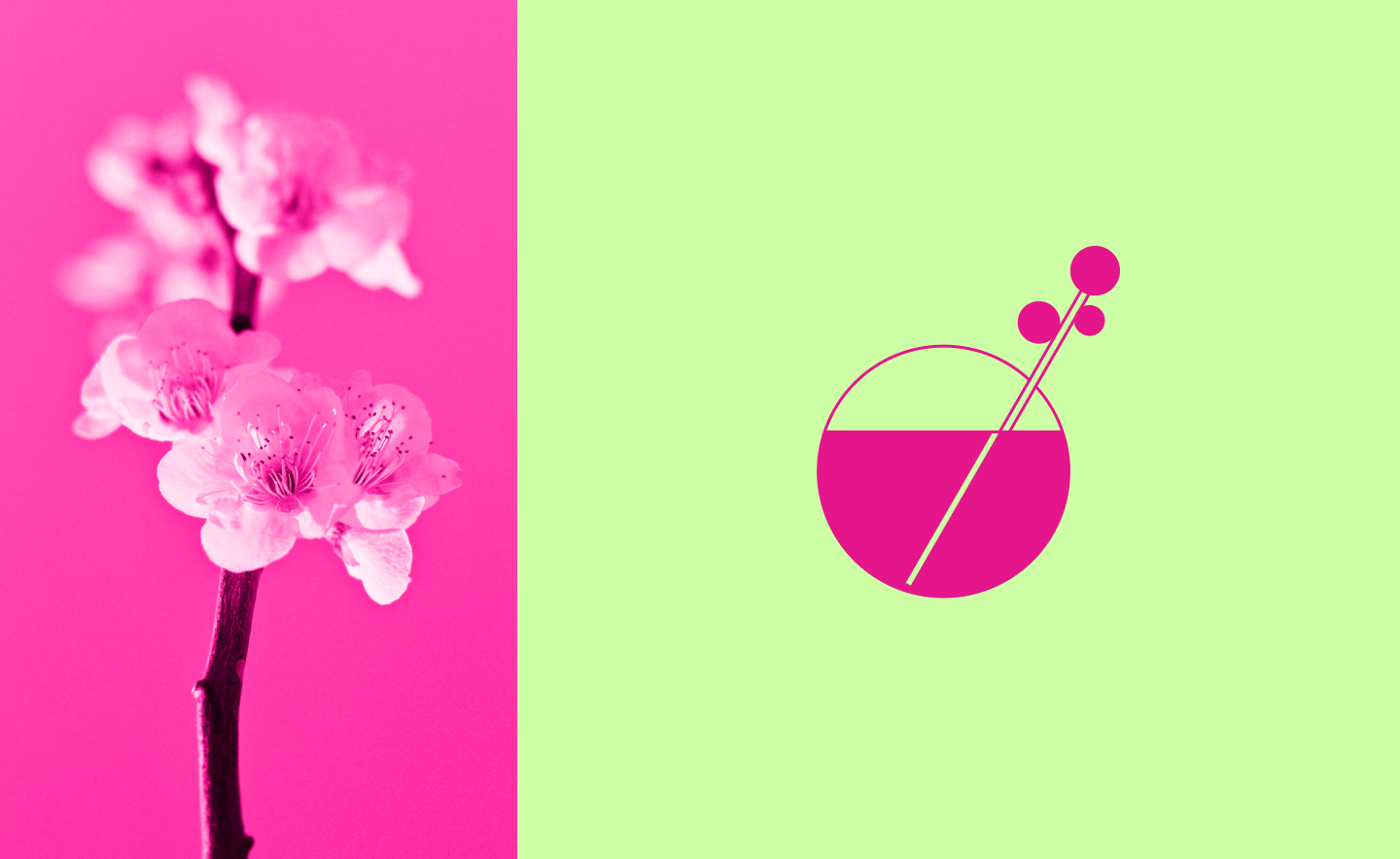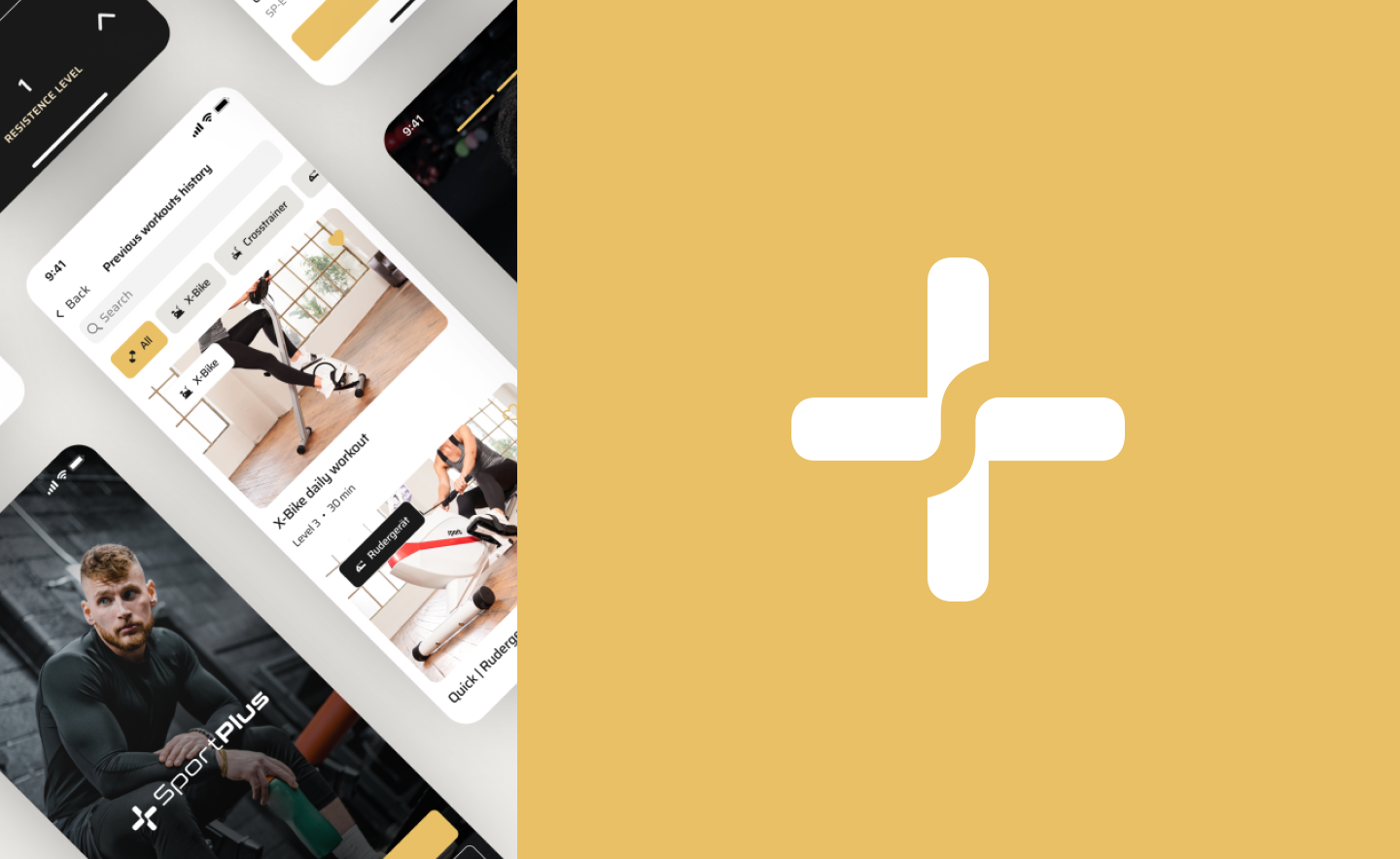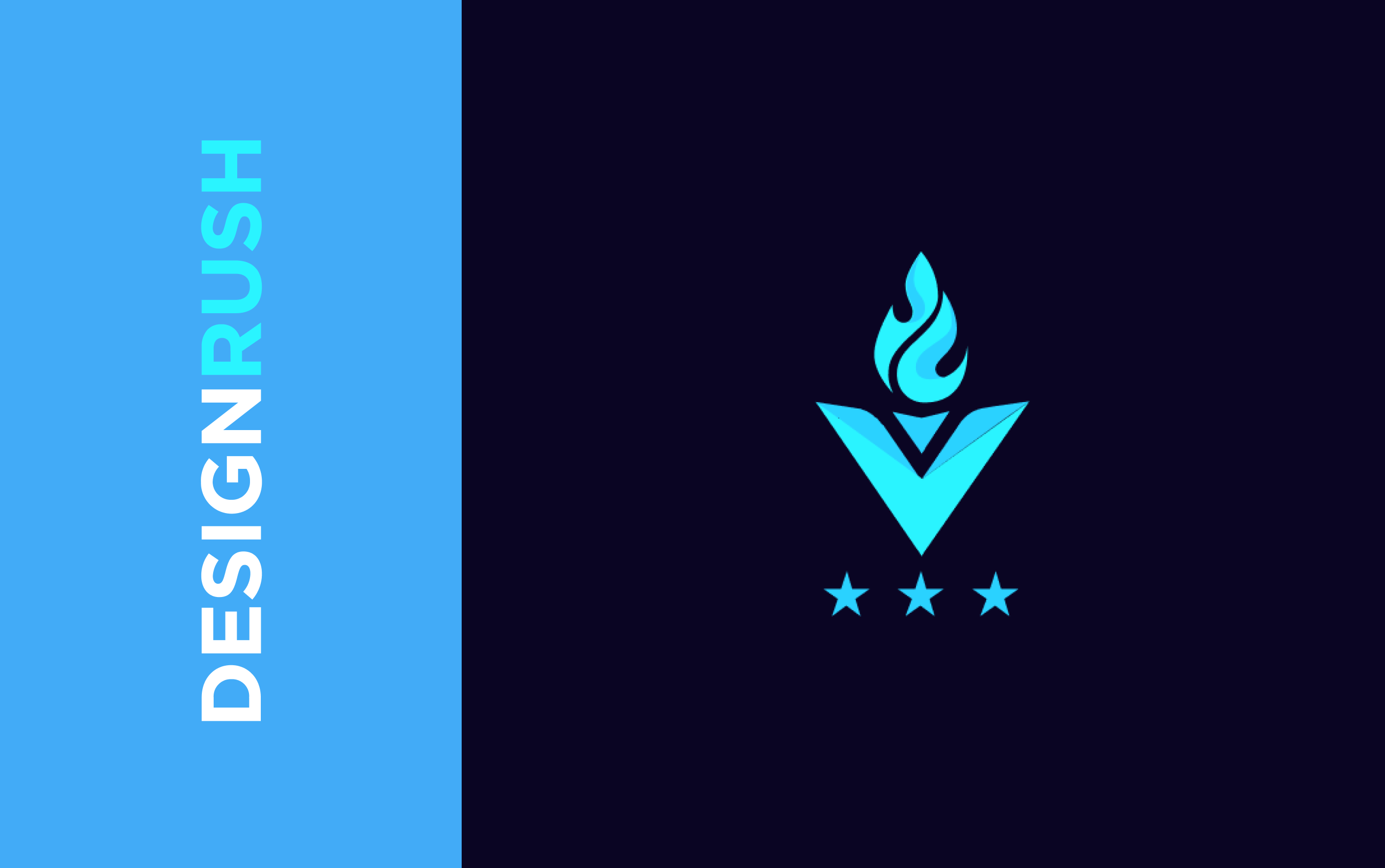Yoga has existed for many years, but it has become trendy worldwide only last few years. The internet is replete with pictures of people in bizarre yoga poses and articles on its usefulness. According to The Good Body, more than 300 million people worldwide practice yoga. Let’s transfer this information to a business point of view. Approximately Americans alone spend $16 billion on yoga every year.
The simplicity and effectiveness of yoga are captivating. Nowadays, many are engaged in this activity to maintain good physical shape and mental health. A 2017 systematic review found that yoga could reduce depressive symptoms in many populations, including people with depressive disorder.
Yoga can be even more effective and accessible with the help of modern technologies. Naturally, this is not a new startup idea. There are many different yoga apps out there. But in this article, we suggest looking at some of the insights that can help you make your yoga application unique, standout, and profitable.
When we talk about a yoga app, it’s not just about money. It’s about helping people. So let’s learn how to save the world from an epidemic of depression by creating a yoga app!
Reasons Why Yoga App is a Popular Trend
Every year, people’s mental and physical health awareness is increasing. And yoga is a great way to improve both. According to statistics, There are over 300 million yoga practitioners worldwide.
It was also influenced by the pandemic of COVID-19, due to which millions of people were forced to stay at home for a long time, left alone with their unrest. As a result, mobile apps have become helpful in everything from food delivery to online education and fitness practice for many people.

The yoga application is one of the types of fitness app, so its popularity raises as much as all fitness market segment does. According to Statista, during the first quarter of 2020, health and fitness apps were downloaded 593 million times. However, in the same quarter of 2019, health and fitness apps were only downloaded 446 million times. In our earlier article, we learned insights on creating fitness app design. As these topics are slightly interconnected, you may be interested in learning them a bit deeper.
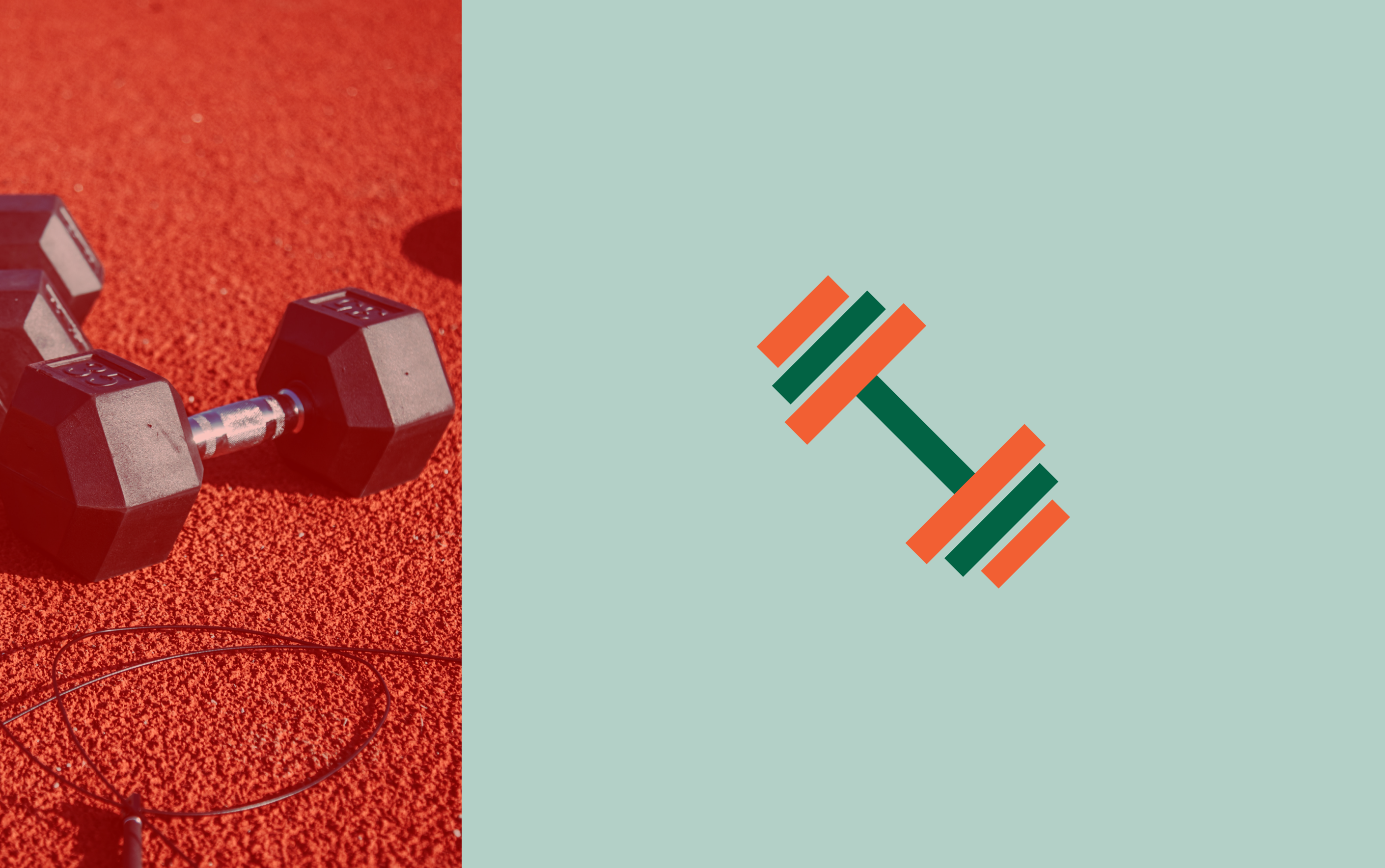
How to Create a Superb Fitness App Design
In a nutshell, yoga apps allow people to practice this activity anywhere and at any time. Users can try different types of yoga to choose the most suitable one for them. Yet, it helps people to stay fit and relaxed. Let’s take a closer look at aspects of the popularity of yoga apps:
-
Progress tracking
Yoga apps allow tracking progress without any effort. Users just need to fill in their age, weight, etc. With this data, apps can help set realistic goals and track the progress in reaching them.
-
Availability of yoga instructors
This type of app offers skilled yoga coaches to guide users in all asanas, nutrition aspects, etc. The great news is that yoga instructors can be available at any time. So if the user feels motivated at 3 AM after watching a fitness blogger’s vlog, it is not a problem to start working out.
-
Motivation
Users receive daily notifications from the yoga app, which adds more motivation to start working out.
-
Cost-saving
An app subscription is cheaper than a physical trainer or coach. According to statistics, On average, a person involved in practicing Yoga spends $90 per month on classes, accessories, and workshop attendance. And the average yoga app subscription costs an average of about $10 a month.
-
No dependency
Users are not limited in location and time.

For now, we know why yoga apps and yoga itself is trendy. But we still didn’t consider the business point of view.
Why Create Yoga App
Referring to AP News, the global yoga market is forecast to reach $66.2 billion by 2027 and is expected to have a compound annual growth rate of 9.6% from 2021 to 2027. So, as you can see, the yoga app development has a great potential that won’t decrease soon.
Whether you are a startup or an existing yoga studio, creating your yoga app is a good investment. Especially if you already have a business, app development can give you a big boost. It can help in retaining customers and acquiring new ones. Yet, you can support more personalized relationships with your customers, which is crucial. The whole market has changed. Only those businesses can compete to build personalized relationships with their customers. Focusing on customer needs is just as important today as creating quality products. One cannot exist without the other.
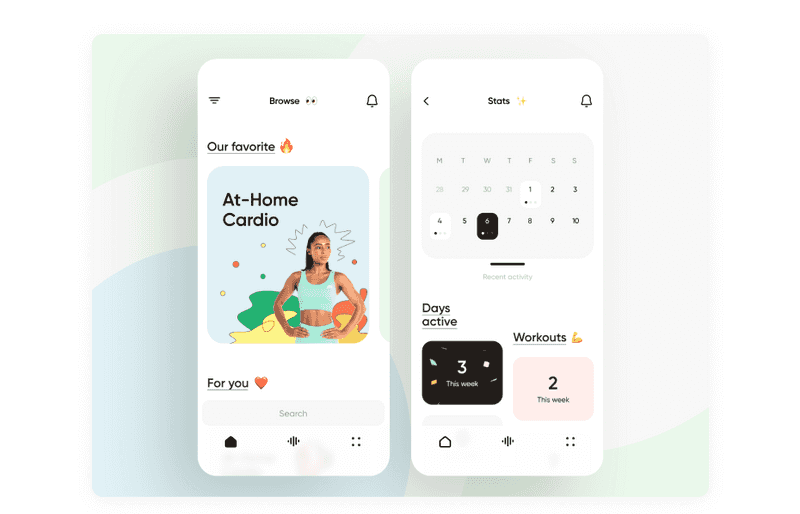
Dribbble shot by Cuberto
If you already have a yoga studio, then the application is an opportunity to work without borders and not lose clients while they are on vacation. Yoga is trendy now, but the application is more flexible for regular communication with customers because everyone stays at home. It is also beneficial for collecting customer data and makes it possible to expand the business and add other types of physical activity: stretching, home workout, etc.
One more reason for creating your yoga app is that people are glued to smartphones now. So if you make a yoga app, your business will always be online. Yet, it is possible to connect the app with social networks, so the users will probably share it with their profiles. Therefore, creating your yoga app gives you a wide range of tools to retain new customers and find new ones all around the globe.
But what audience is it possible to reach with all of these tools and benefits?
What Audience Yoga App Targets
Defining the target audience for the future yoga application is crucial because it will affect features that need to be included. In our experience, several user persons can be distinguished: practitioners, yoga coaches, administrators, and event organizers. And if you want to study the audience and its needs in more detail to create the correct user persona, read our article on UX research.

Essential UX Research Methods For Your Business
So, there are three types of potential users (proto personas) for yoga apps:
-
Practitioners
Most of the audience those who practice yoga are women. According to statistics, women account for 72% of yoga practitioners. But men are also on the users’ list.
-
Yoga coaches
If you want to make a yoga teacher app, you need to consider some unique features to create yoga sessions and showcase them to users.
-
Admins
This segment of the audience belongs to the actual owners of the application. They gather data, manage users and yoga teachers.

After we learn about the target audience, it is time to determine what features are needed to create a superb yoga app. We hope you are ready to know this information.
Critical Features for Yoga App
These features are the key ones to include in the yoga app. It is doesn’t matter who your target audience is. You need to build a great product, and from our point of view, a good yoga app can’t be so without these features:
-
Registration and login
It allows users to create an account by filling in basic information like email, name, age, etc. Yet, you can provide the ability to log in via social media, which makes the registration process easier and faster.
-
Personal profile
Here users can manage their profiles, fill in additional information, add a profile picture, see purchased items, bookings, and other helpful information.
-
Yoga sessions
With this feature, users can see what yoga types and sessions are provided and choose the suitable one basis on level of expertise, duration, rating, and reviews.
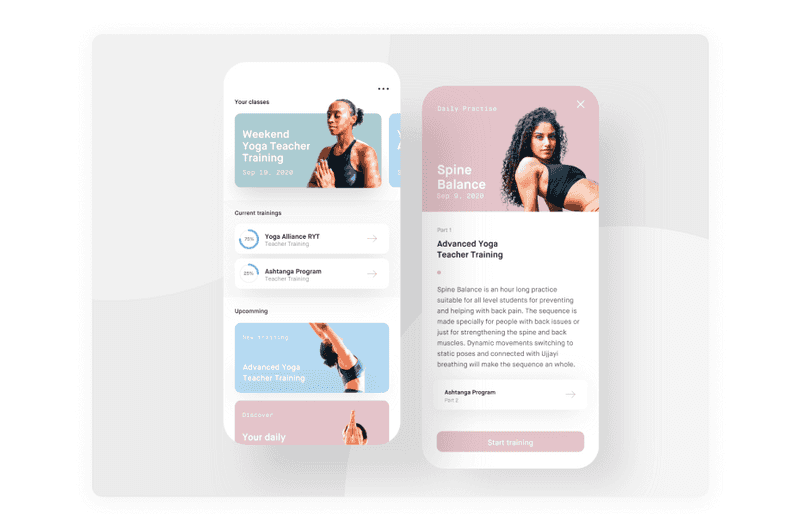
Dribbble shot by Aga Jucha-Kasperczyk
-
Favorites
Let users save their favorite sessions or even cash them so it will be possible to have a workout without an Internet connection.
-
Live yoga sessions
There, users can take a real-time yoga session. In addition, provide them with the choice between different coaches, levels, and yoga types.
-
Subscription plan
It is one more way to profit from creating a yoga online app. There can be subscription plans for different levels, monthly goals, or a subscription plan for a year. We will talk about it in detail later in our article.
-
Notifications
With it, users will receive engaging notifications about updates, upcoming events, and new articles on the blog.
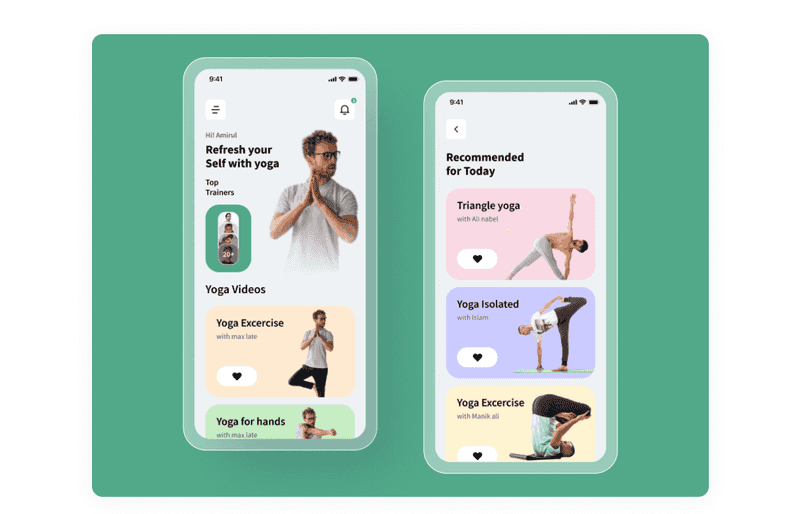
Dribbble shot by NovoStack
These features are more suitable for the practitioners’ part of the target audience discussed above. But what features can make your yoga app more outstanding? Let’s find out!
Additional Features for Yoga App
These features are not crucial, but they will make your yoga app more exciting and competitive among other similar applications.
-
Gamification
People like challenges. Provide users with the feeling of accomplishment by giving them badges or awards for completing goals or workouts a few days in a row. This feature will keep your engagement and retention rating high.
-
Social sharing
Let users share their favorite sessions, accomplishments, and thoughts on social media. It is beneficial not only for your audience but also for your business. In addition, you may gain new users with this feature.
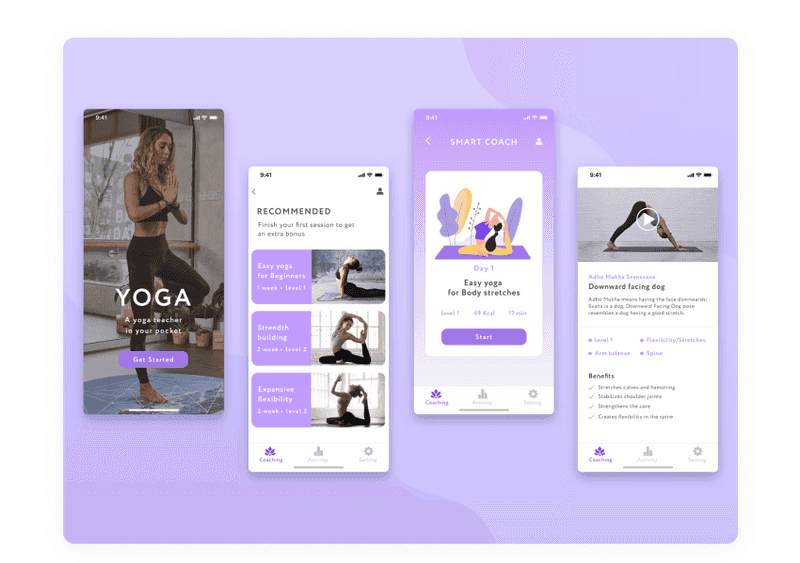
Dribbble shot by Victoria Sivakova
-
Community
Let people share their results in the community dashboard. It can also help users to stay more motivated.
-
Goal setting
Give more motivation to your users by giving them the ability to set goals.
-
Leaderboard
The leaderboard integration would keep users more motivated. For example, let users gain points for completed sessions or courses to increase the rating.
-
Video subtitles
Take care of the segment of users who have hearing defects or don’t know your app’s language that well.
-
Voice instruction
In the course of sessions, it is not always possible to constantly look at the screen. Therefore, voice instructions will come in handy. In addition, it will make your application more user-friendly.
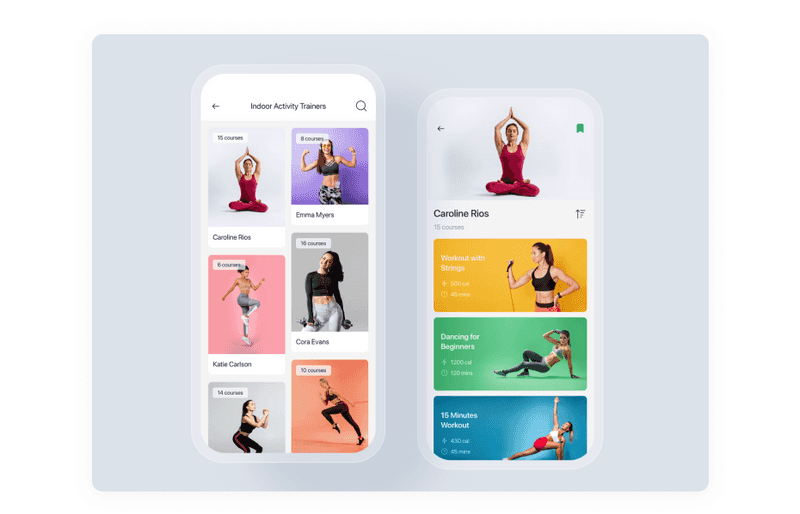
Dribbble shot by HoangPts
-
Connect to music
You can allow users to turn on the music they like by connecting to music streaming apps.
-
AR functions
Users can use wearable devices with built-in AR technology to check their workouts. These devices can record all indicators during practice, and with their help, it is possible to control how correctly the applications are being executed.
-
VR functions
It can completely replace going to the gym. Users who have VR equipment can connect and practice at home as if in a full-fledged gym with a trainer, which creates a refreshing atmosphere for productive activities.
-
Chat with the instructor
Provide users with a chat with the coaches to ask them questions and help newbies in yoga practice. Yet, it can build a strong relationship between your studio or just the app and customers.
-
Personal sessions
The user can schedule personal training with the coach. It could be beneficial for newbies.
-
Wearable and non-wearable devices integration
These devices help you track parameters such as heart rate, calories burned, and exercise intensity. It allows users to keep track of their health and even motivates them.
-
Activity summary
Let users see how good they have done the workout. These results can be more accurate with wearable-and non-wearable integration features.
-
eStore
Many yoga and meditation apps offer eStore facilities, where users can buy different accessories like mats, sports clothes, and other related things. With it, you can get even more profit if you create your own meditation app or yoga app. It works this way: the user taps on the eStore icon, which directs them to eStore, where all items are categorized by type, price, etc. Users may choose items for instant purchase or save them to the wishlist for later.
-
Book event ticket
In this section, users can see all upcoming events. You can set categories for it, making it easier for users to find exciting events. This feature can help you to not only build a good app but it would also help create a community around it, which is great for users. There, users also can book tickets, pay for them via different payment systems. Don’t forget to add several payment options to find the most suitable one.
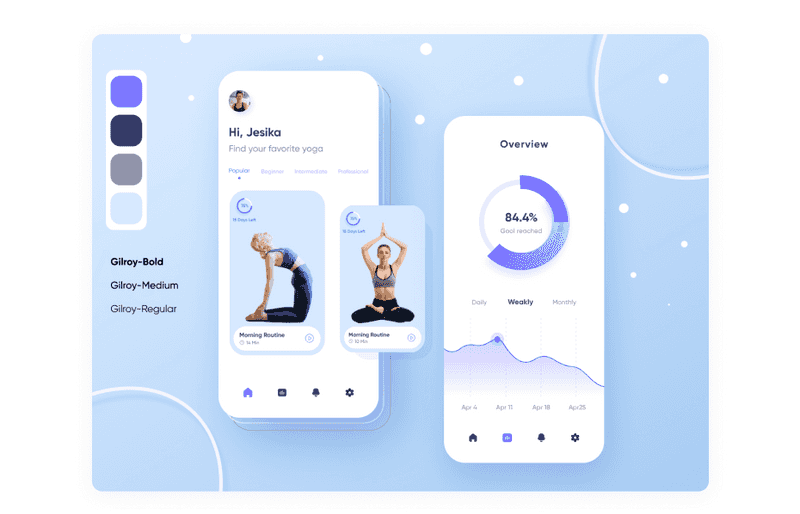
Dribbble shot by Amanullah
-
Personal AI coach
AI (Artificial Intelligence) changes the fitness industry. It works like a chatbot that can support users while practicing, which is helpful.
We know how to make the app attractive and helpful for users. But what about the coaches’ segment of the target audience? Let’s dive into this together!
Features to Include in an App for Yoga Teachers
What features do you need to add to make your yoga app comfortable for coaches? Depending on the complexity, it can be a separate application (like Uber and Uber Drive) or one for all.
-
Registration
Yoga teachers can create accounts via Google, email, or social media.
-
Manage sessions
There, coaches can create sessions and schedule bookings for them.
-
Program creation
Coaches can suggest yoga programs for the app to attract more users. Since they are experts in this, this feature can be helpful to make your yoga online app better.
-
Payment checking
The teachers can check all paid and unpaid lessons there.
-
Calendar scheduling
With this feature, coaches can schedule available sessions and times when free or busy. It is beneficial not only for themselves but also for users because users will see when a particular coach is available.
-
Launch training programs
The coaches can launch their training programs to the app so that the users will see it. These can be free or paid ones. With this feature, your app becomes a pocket yoga practice builder where every trainer can add something valuable to default programs.
-
Profile management
Coaches can edit their profiles, add relevant information about their experience and approach to work.

Dribbble shot by Insight Timer
-
Push notifications
With this feature, coaches can receive notifications about an upcoming session, a canceled session, a payment received, and more.
All these features for coaches overlap a little with user ones because there is a direct interaction between them. But there is another one target audience segment that needs special features. It is about admins. Ready? Then, let’s go!
Features in Yoga app for Admins
As we mentioned above, admins are the yoga online app owners. Some features would help them to gather information and supervise the app:
-
Sign in
This feature allows admins to log in with their credentials.
-
Dashboard
The administrator can display all teachers and users there.
-
User management
The admin can activate, delete, or edit practitioners, teachers, or event organizers.
-
Content and session management
With this feature, the admin can manage training sessions, add new ones, or delete them if it is needed.
-
Manage offers
Admins may receive different offers from event organizers and coaches. It is easy to add, delete, or edit with this feature.
-
Categories management
Admins can add new categories, delete them, or edit them using this feature.

-
Payment management
With this feature, the admin can track all transactions.
-
Reports
There, admins can receive all data related to clicks, traffic, and revenue generated.
-
CMS integration
The Content Management System can help check the published content’s uniqueness and organize it.
-
CRM integration
A Customer Relationship Management system can help create a base of customers to send them personalized notifications and offers.
-
Marketing tools
Various marketing tools help you create ads, promote, and segment your audience. You can choose convenient marketing tools for yourself because of many of them.
-
Integrations
There can be different tools such as Slack, Google Drive, Stripe, Sendbird, or else that can help in making the work process smoother.
-
Manage store
With this feature, admins can add products to the eStore, edit them, sort them, and control their availability.

Well, with features for admins, everything is clear now. So what features are needed for coaches?
We now know all about the features you need to create the perfect yoga app. So naturally, such an application will attract users and stand out in the market, which will bring profit to the business and benefit people. But how else can you get profit from this venture?
Ways to Monetize Yoga App
Of course, it’s excellent to create products that benefit people. But it’s even better when the product also benefits the business. Why else are we all gathered here today? Paid features add value to the product and can play as additional motivation because the user will have to use precisely what they paid for. So, the monetization ways are:
-
Subscription
In this monetization model, users are given a free period to get acquainted with the application’s features. Then, the user pays for a subscription for a week, month, or year at the end of the period.
-
In-app purchase
In this monetization model, you can invite users to buy certain premium features of your application, coaching sessions, consultations, personal training plans, and more.
-
Pay-per download
The user pays to download the application. But this monetization method is rarely used since users do not want to buy a pig in a poke.
-
Ads
You can place ads for services or sites from a similar business niche in your application and get paid for it.
-
eCommerce integration
You can integrate eCommerce into your app to sell different yoga supplies, guides, sportswear. It will make the brand position stronger and attract more users.
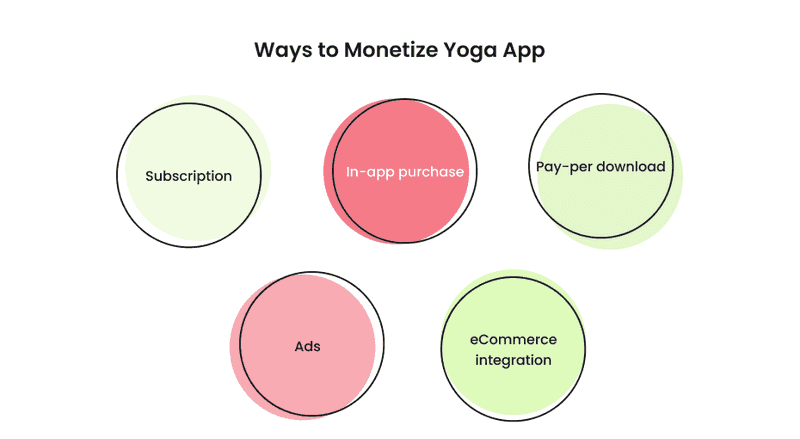
Once you have decided on the monetization model and the features that will be present in your application, it’s time to find out how the application is being made.
How to Design a Yoga App?
The first thing a project starts with is a research project. Then, user research is carried out to identify the target audience and create user personas. In the future, this will help create a design and a promotion scheme for the application. Further, based on the data obtained, an idea is formed. Finally, the central concept of the application is drawn up, and the design team begins to think about the user scenario.
User scenario helps to understand all possible paths of the user in the application to achieve his goal. Based on this, designers create an information architecture to understand how content should be placed in an application.
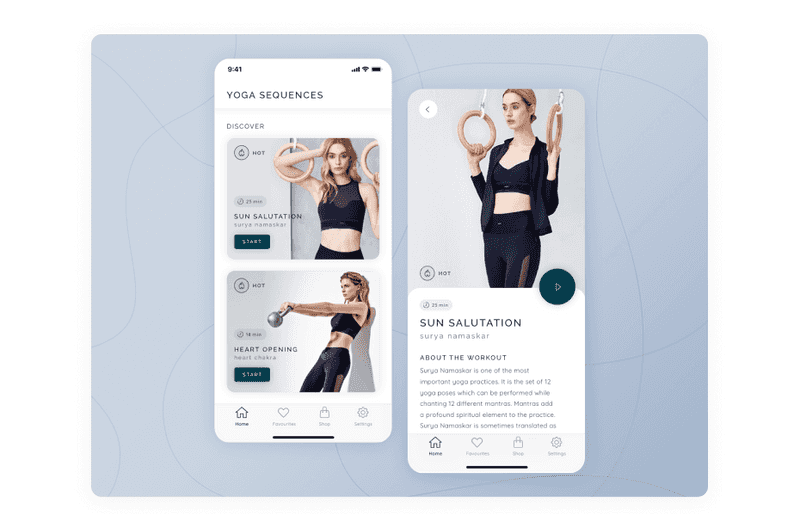
Dribbble shot by App’n’Roll
Next, wireframes are compiled. Finally, it is necessary to see the structure of the application visually. There is nothing about design in this part. Here, only about the user experience. The main task of this stage is to make the application as user-friendly as possible.
After the approval of the wireframes, prototyping follows. First, low-fidelity prototypes are created, then highly-fidelity ones. Prototypes are a great way to test a version of an application with real users. In addition, bugs or ways to improve the application can be identified during this process.
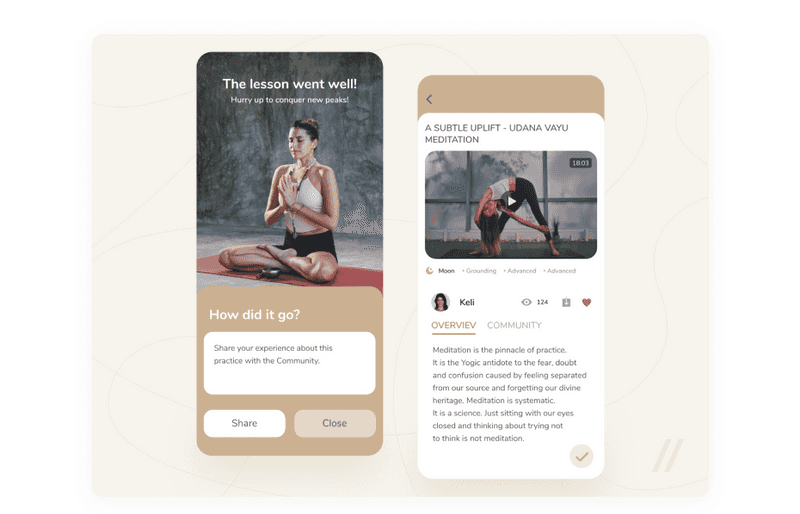
Dribbble shot by Purrweb UI/UX Studio
Also, the design team can already start to polish the design on high-fidelity prototypes. The UI design in the yoga app is something between meditation app and fitness app design. There should be calm colors, few distracting design elements. Illustrations and animations can show how to perform a particular asana. Also, animations and graphics look good in the onboarding part.
Here we have outlined the design process in a nutshell. To learn more about it, read our previous article on it.

How Do the Perfect Design Process Steps Look? Everything You Need to Know
Challenges in Creating Yoga App
Each project has its challenges. Also, yoga apps have some snags that need to be resolved.
-
Cross-platform adaptation
IOS and Android are the most popular when it comes to platform choice. However, both of these platforms have guidelines that need to be followed. So, when creating a yoga studio app for android, think about the iOS version too. This way, you will capture a more significant segment of your audience.
-
Accessibility
We usually talk about people with visual, hearing, or motor impairments. But in this case, the application should be available to people in the position of the head down asana. It means that users should receive instructions on what to do next, even in this body position.
-
Content structuring
Such applications usually have a lot of different content. These are videos and articles and just illustrations with the exercise technique. Therefore, it is essential to sort the content correctly and arrange it well on the screen so that the user does not find the right content. At the same time, the screen should not be too crowded.
-
Individual content
There is a wide variety of yoga apps on the market. However, you need to pay special attention to the content to make your app stand out from the rest.
-
Proper sessions’ plans
Many different workout variations need to be considered to create the right training plan or help the user achieve a goal that is achievable for their level.
-
Managing the big data
This type of application usually has to deal with a lot of information and content. Therefore, it is essential to consider designing your application to handle a lot of information without any problems.
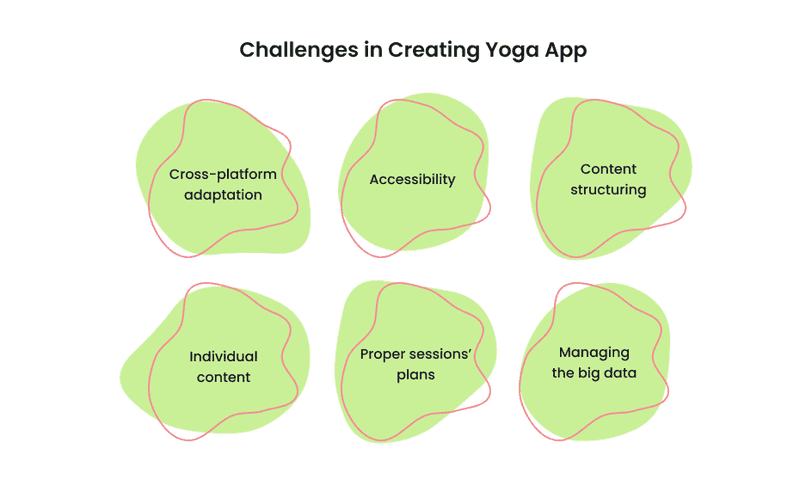
Each segment of the app market has its challenges to overcome. But, sometimes, they can, on the contrary, play into the hands and give impetus to a new idea, which may turn the concept of yoga apps upside down.
Final Words
There are many benefits that yoga apps bring to people by relieving them of stress. It is also beneficial for users and businesses since the fitness industry is rapidly gaining momentum, and a decline is not expected in the next few years.
Yoga app development is a great idea both for startups and existing businesses. Creating an app can boost your business if you already have a yoga studio. In another case, this is not an isolated case when a small startup becomes successful by launching an application.
Making yoga apps unique and different from others is difficult but possible. Our Axicube team has experience in building fitness apps and many other projects. We have worked with startups and businesses of different sizes and segments. We a glad to offer our rich experience to bring your idea to life.
